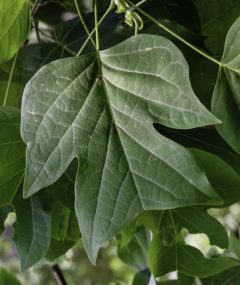As Minnesota’s climate shifts warmer and wetter, we know that we will see our forests change in response. Boreal species at the southern edge of their current range will face increasing climate stress, and more hardwood species may slowly take their place. Eventually, some of those trees will be species not currently seen in Minnesota but found further south.
Recently, we traveled to Kentucky to present the work we’ve been doing around creating climate-ready woodlands. We also hoped to talk to foresters from the area to learn about managing many tree species found in the central hardwood region.
The central hardwood region covers parts of Kentucky, Tennessee, Indiana, Illinois, Missouri and Arkansas. This ecoregion is characterized by a diversity of hardwood species — familiar ones such as oak and hickory, as well as less familiar species like tulip poplar and sweetgum. Conifers such as shortleaf pine and Minnesota native species eastern white pine can be found here as well. Could the trees now found in Kentucky eventually find a suitable habitat in Minnesota’s future climate?
There are some pretty big differences between Minnesota’s and Kentucky’s forest ecosystems. For example, it seems that oak wilt is not a major issue for the oak forests of the central hardwood region. This may be due to the greater diversity of hardwood species, which may limit the spread of oak wilt between individual oak trees. In Minnesota, oak makes up about 10% of our forests, and oak wilt spreads relatively quickly between red oak species, especially on sites with sandy soil.
Another oddity: species were found to be growing in very different sites in the central hardwood region than their usual habitats here in Minnesota. Here, white oak typically grows on wet sites and northern red oak grows on dry sites. In the central hardwoods, however, often the opposite is true. This was quite a surprise to us.
We spent one day hiking in eastern Kentucky in the Daniel Boone National Forest, where we saw many hardwood and conifer species, such as tulip poplar, Virginia pine and American holly. The most surprising species we found, however, was eastern hemlock. And we didn’t see just a few individual hemlock trees — we encountered an entire grove of mature hemlocks with plenty of seedlings and saplings in the understory.
In Minnesota, eastern hemlock is endangered and one of the state’s rarest trees, with limited occurrences across the state. However, eastern hemlock is more abundant just to the east of Minnesota, such as in Wisconsin, Michigan, and, of course, Kentucky.
It’s interesting to think about how the changing climate could affect not only the species we manage but also how we manage them. We are excited to use our new knowledge and connections to improve Extension’s programming around forest climate adaptation.


